Input interpretation

H_2SO_4 (sulfuric acid) + Ba (barium) ⟶ H_2O (water) + H_2S (hydrogen sulfide) + BaSO_4 (barium sulfate)
Balanced equation
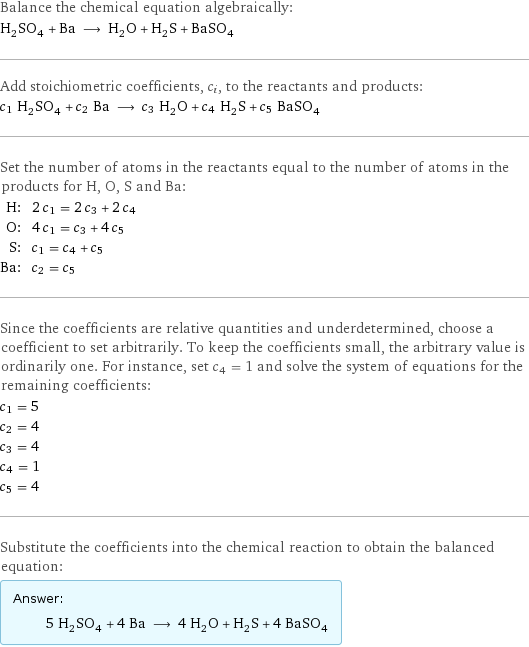
Balance the chemical equation algebraically: H_2SO_4 + Ba ⟶ H_2O + H_2S + BaSO_4 Add stoichiometric coefficients, c_i, to the reactants and products: c_1 H_2SO_4 + c_2 Ba ⟶ c_3 H_2O + c_4 H_2S + c_5 BaSO_4 Set the number of atoms in the reactants equal to the number of atoms in the products for H, O, S and Ba: H: | 2 c_1 = 2 c_3 + 2 c_4 O: | 4 c_1 = c_3 + 4 c_5 S: | c_1 = c_4 + c_5 Ba: | c_2 = c_5 Since the coefficients are relative quantities and underdetermined, choose a coefficient to set arbitrarily. To keep the coefficients small, the arbitrary value is ordinarily one. For instance, set c_4 = 1 and solve the system of equations for the remaining coefficients: c_1 = 5 c_2 = 4 c_3 = 4 c_4 = 1 c_5 = 4 Substitute the coefficients into the chemical reaction to obtain the balanced equation: Answer: | | 5 H_2SO_4 + 4 Ba ⟶ 4 H_2O + H_2S + 4 BaSO_4
Structures

+ ⟶ + +
Names

sulfuric acid + barium ⟶ water + hydrogen sulfide + barium sulfate
Reaction thermodynamics
Enthalpy
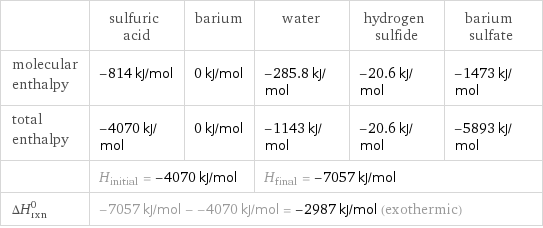
| sulfuric acid | barium | water | hydrogen sulfide | barium sulfate molecular enthalpy | -814 kJ/mol | 0 kJ/mol | -285.8 kJ/mol | -20.6 kJ/mol | -1473 kJ/mol total enthalpy | -4070 kJ/mol | 0 kJ/mol | -1143 kJ/mol | -20.6 kJ/mol | -5893 kJ/mol | H_initial = -4070 kJ/mol | | H_final = -7057 kJ/mol | | ΔH_rxn^0 | -7057 kJ/mol - -4070 kJ/mol = -2987 kJ/mol (exothermic) | | | |
Entropy
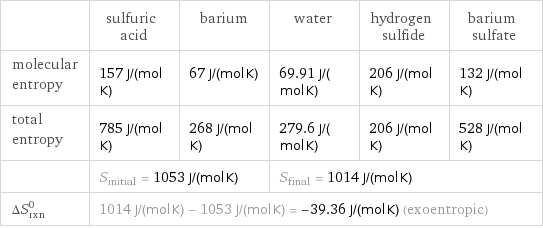
| sulfuric acid | barium | water | hydrogen sulfide | barium sulfate molecular entropy | 157 J/(mol K) | 67 J/(mol K) | 69.91 J/(mol K) | 206 J/(mol K) | 132 J/(mol K) total entropy | 785 J/(mol K) | 268 J/(mol K) | 279.6 J/(mol K) | 206 J/(mol K) | 528 J/(mol K) | S_initial = 1053 J/(mol K) | | S_final = 1014 J/(mol K) | | ΔS_rxn^0 | 1014 J/(mol K) - 1053 J/(mol K) = -39.36 J/(mol K) (exoentropic) | | | |
Equilibrium constant
![Construct the equilibrium constant, K, expression for: H_2SO_4 + Ba ⟶ H_2O + H_2S + BaSO_4 Plan: • Balance the chemical equation. • Determine the stoichiometric numbers. • Assemble the activity expression for each chemical species. • Use the activity expressions to build the equilibrium constant expression. Write the balanced chemical equation: 5 H_2SO_4 + 4 Ba ⟶ 4 H_2O + H_2S + 4 BaSO_4 Assign stoichiometric numbers, ν_i, using the stoichiometric coefficients, c_i, from the balanced chemical equation in the following manner: ν_i = -c_i for reactants and ν_i = c_i for products: chemical species | c_i | ν_i H_2SO_4 | 5 | -5 Ba | 4 | -4 H_2O | 4 | 4 H_2S | 1 | 1 BaSO_4 | 4 | 4 Assemble the activity expressions accounting for the state of matter and ν_i: chemical species | c_i | ν_i | activity expression H_2SO_4 | 5 | -5 | ([H2SO4])^(-5) Ba | 4 | -4 | ([Ba])^(-4) H_2O | 4 | 4 | ([H2O])^4 H_2S | 1 | 1 | [H2S] BaSO_4 | 4 | 4 | ([BaSO4])^4 The equilibrium constant symbol in the concentration basis is: K_c Mulitply the activity expressions to arrive at the K_c expression: Answer: | | K_c = ([H2SO4])^(-5) ([Ba])^(-4) ([H2O])^4 [H2S] ([BaSO4])^4 = (([H2O])^4 [H2S] ([BaSO4])^4)/(([H2SO4])^5 ([Ba])^4)](../image_source/c885d848b22e336a8ad1dd17361eb95f.png)
Construct the equilibrium constant, K, expression for: H_2SO_4 + Ba ⟶ H_2O + H_2S + BaSO_4 Plan: • Balance the chemical equation. • Determine the stoichiometric numbers. • Assemble the activity expression for each chemical species. • Use the activity expressions to build the equilibrium constant expression. Write the balanced chemical equation: 5 H_2SO_4 + 4 Ba ⟶ 4 H_2O + H_2S + 4 BaSO_4 Assign stoichiometric numbers, ν_i, using the stoichiometric coefficients, c_i, from the balanced chemical equation in the following manner: ν_i = -c_i for reactants and ν_i = c_i for products: chemical species | c_i | ν_i H_2SO_4 | 5 | -5 Ba | 4 | -4 H_2O | 4 | 4 H_2S | 1 | 1 BaSO_4 | 4 | 4 Assemble the activity expressions accounting for the state of matter and ν_i: chemical species | c_i | ν_i | activity expression H_2SO_4 | 5 | -5 | ([H2SO4])^(-5) Ba | 4 | -4 | ([Ba])^(-4) H_2O | 4 | 4 | ([H2O])^4 H_2S | 1 | 1 | [H2S] BaSO_4 | 4 | 4 | ([BaSO4])^4 The equilibrium constant symbol in the concentration basis is: K_c Mulitply the activity expressions to arrive at the K_c expression: Answer: | | K_c = ([H2SO4])^(-5) ([Ba])^(-4) ([H2O])^4 [H2S] ([BaSO4])^4 = (([H2O])^4 [H2S] ([BaSO4])^4)/(([H2SO4])^5 ([Ba])^4)
Rate of reaction
![Construct the rate of reaction expression for: H_2SO_4 + Ba ⟶ H_2O + H_2S + BaSO_4 Plan: • Balance the chemical equation. • Determine the stoichiometric numbers. • Assemble the rate term for each chemical species. • Write the rate of reaction expression. Write the balanced chemical equation: 5 H_2SO_4 + 4 Ba ⟶ 4 H_2O + H_2S + 4 BaSO_4 Assign stoichiometric numbers, ν_i, using the stoichiometric coefficients, c_i, from the balanced chemical equation in the following manner: ν_i = -c_i for reactants and ν_i = c_i for products: chemical species | c_i | ν_i H_2SO_4 | 5 | -5 Ba | 4 | -4 H_2O | 4 | 4 H_2S | 1 | 1 BaSO_4 | 4 | 4 The rate term for each chemical species, B_i, is 1/ν_i(Δ[B_i])/(Δt) where [B_i] is the amount concentration and t is time: chemical species | c_i | ν_i | rate term H_2SO_4 | 5 | -5 | -1/5 (Δ[H2SO4])/(Δt) Ba | 4 | -4 | -1/4 (Δ[Ba])/(Δt) H_2O | 4 | 4 | 1/4 (Δ[H2O])/(Δt) H_2S | 1 | 1 | (Δ[H2S])/(Δt) BaSO_4 | 4 | 4 | 1/4 (Δ[BaSO4])/(Δt) (for infinitesimal rate of change, replace Δ with d) Set the rate terms equal to each other to arrive at the rate expression: Answer: | | rate = -1/5 (Δ[H2SO4])/(Δt) = -1/4 (Δ[Ba])/(Δt) = 1/4 (Δ[H2O])/(Δt) = (Δ[H2S])/(Δt) = 1/4 (Δ[BaSO4])/(Δt) (assuming constant volume and no accumulation of intermediates or side products)](../image_source/a8fe34730ee1b505f78b81cbdfadce9e.png)
Construct the rate of reaction expression for: H_2SO_4 + Ba ⟶ H_2O + H_2S + BaSO_4 Plan: • Balance the chemical equation. • Determine the stoichiometric numbers. • Assemble the rate term for each chemical species. • Write the rate of reaction expression. Write the balanced chemical equation: 5 H_2SO_4 + 4 Ba ⟶ 4 H_2O + H_2S + 4 BaSO_4 Assign stoichiometric numbers, ν_i, using the stoichiometric coefficients, c_i, from the balanced chemical equation in the following manner: ν_i = -c_i for reactants and ν_i = c_i for products: chemical species | c_i | ν_i H_2SO_4 | 5 | -5 Ba | 4 | -4 H_2O | 4 | 4 H_2S | 1 | 1 BaSO_4 | 4 | 4 The rate term for each chemical species, B_i, is 1/ν_i(Δ[B_i])/(Δt) where [B_i] is the amount concentration and t is time: chemical species | c_i | ν_i | rate term H_2SO_4 | 5 | -5 | -1/5 (Δ[H2SO4])/(Δt) Ba | 4 | -4 | -1/4 (Δ[Ba])/(Δt) H_2O | 4 | 4 | 1/4 (Δ[H2O])/(Δt) H_2S | 1 | 1 | (Δ[H2S])/(Δt) BaSO_4 | 4 | 4 | 1/4 (Δ[BaSO4])/(Δt) (for infinitesimal rate of change, replace Δ with d) Set the rate terms equal to each other to arrive at the rate expression: Answer: | | rate = -1/5 (Δ[H2SO4])/(Δt) = -1/4 (Δ[Ba])/(Δt) = 1/4 (Δ[H2O])/(Δt) = (Δ[H2S])/(Δt) = 1/4 (Δ[BaSO4])/(Δt) (assuming constant volume and no accumulation of intermediates or side products)
Chemical names and formulas
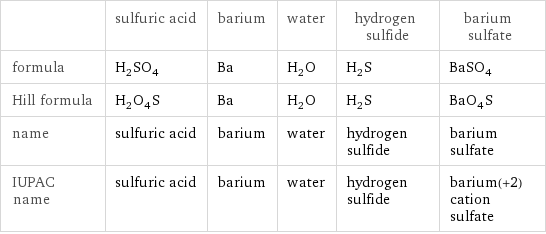
| sulfuric acid | barium | water | hydrogen sulfide | barium sulfate formula | H_2SO_4 | Ba | H_2O | H_2S | BaSO_4 Hill formula | H_2O_4S | Ba | H_2O | H_2S | BaO_4S name | sulfuric acid | barium | water | hydrogen sulfide | barium sulfate IUPAC name | sulfuric acid | barium | water | hydrogen sulfide | barium(+2) cation sulfate
Substance properties
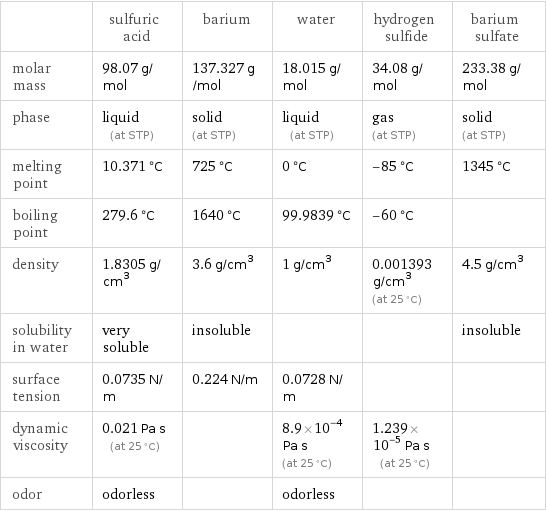
| sulfuric acid | barium | water | hydrogen sulfide | barium sulfate molar mass | 98.07 g/mol | 137.327 g/mol | 18.015 g/mol | 34.08 g/mol | 233.38 g/mol phase | liquid (at STP) | solid (at STP) | liquid (at STP) | gas (at STP) | solid (at STP) melting point | 10.371 °C | 725 °C | 0 °C | -85 °C | 1345 °C boiling point | 279.6 °C | 1640 °C | 99.9839 °C | -60 °C | density | 1.8305 g/cm^3 | 3.6 g/cm^3 | 1 g/cm^3 | 0.001393 g/cm^3 (at 25 °C) | 4.5 g/cm^3 solubility in water | very soluble | insoluble | | | insoluble surface tension | 0.0735 N/m | 0.224 N/m | 0.0728 N/m | | dynamic viscosity | 0.021 Pa s (at 25 °C) | | 8.9×10^-4 Pa s (at 25 °C) | 1.239×10^-5 Pa s (at 25 °C) | odor | odorless | | odorless | |
Units
